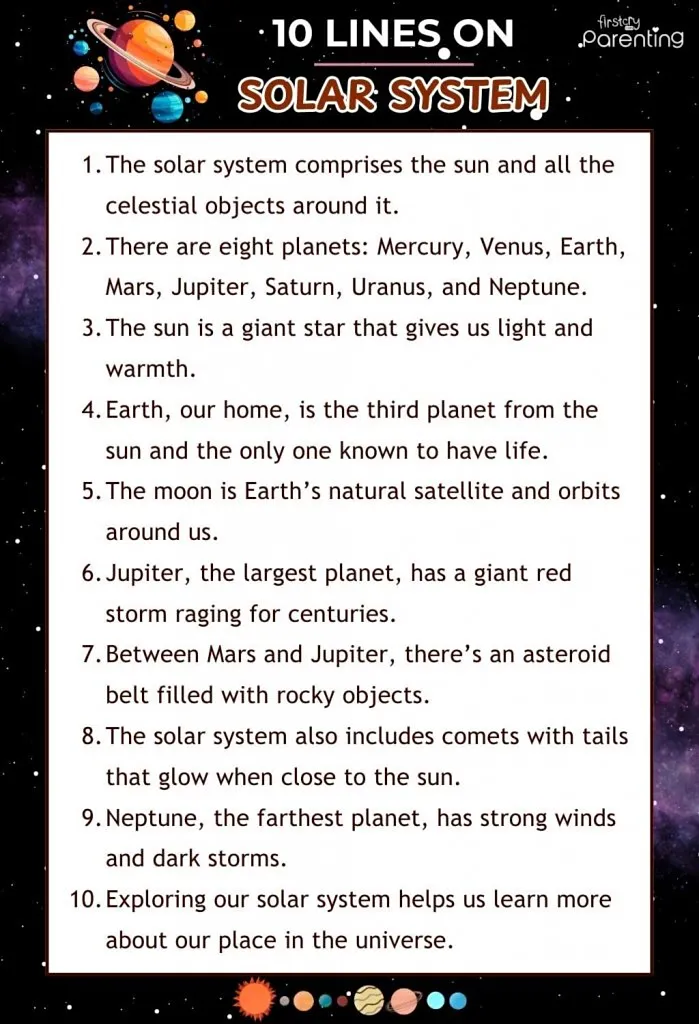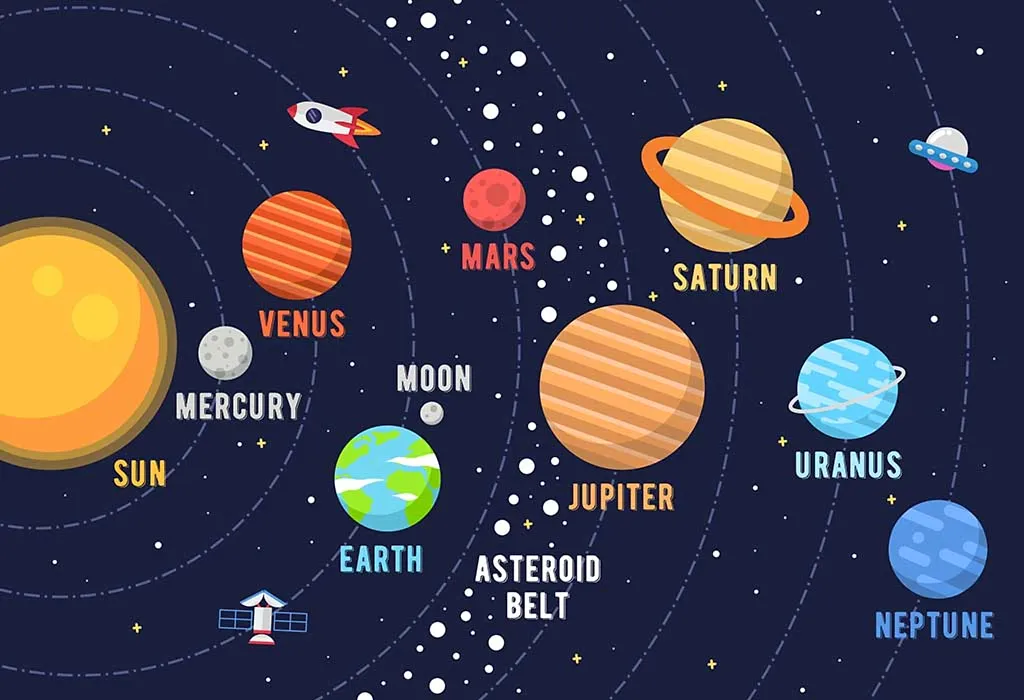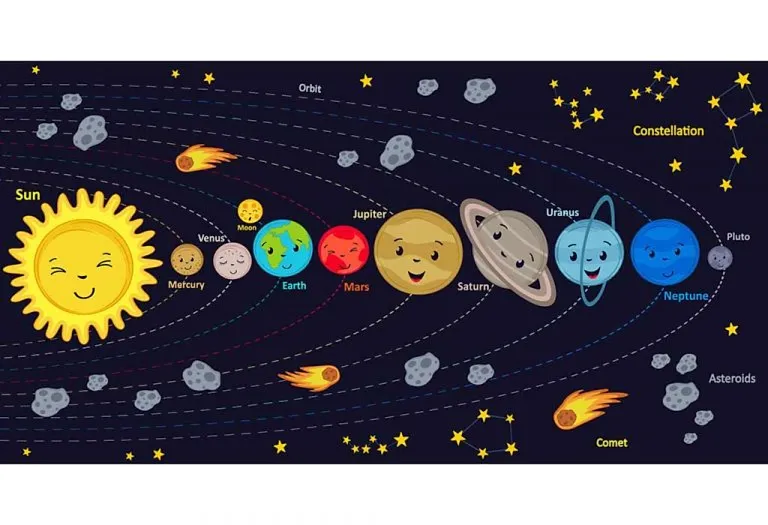Essay On Solar System – 10 Lines, Short and Long Essay for Children and Students
- Key Points to Remember When Writing an Essay on the Solar System
- 10 Lines on Solar System
- A Paragraph on Solar System
- Short Essay on Solar System
- Long Essay of the Solar System in English
- What Will Your Child Learn From the Essay on the Solar System?
- FAQs
Writing essays can be an incredible journey of exploration, especially when diving into fascinating topics like the solar system. A solar system essay, like the one we’re about to embark on, provides an opportunity to understand the vast universe we are a part of. By attempting this essay in English, students can improve their language skills, enhance their creativity, and develop a deeper appreciation for the wonders beyond our planet. Now, let’s travel through space and time to understand the marvellous entity we call the solar system.
Key Points to Remember When Writing an Essay on the Solar System
When you embark on the enlightening journey of writing an essay on the solar system, it’s essential to remember some fundamental aspects to make your essay stand out. These points ensure that your content is rich and informative and captivates your readers.
- Research Thoroughly: Before starting, gather information from credible sources. The solar system is vast, and discoveries are made regularly.
- Keep It Organised: Structure your essay with a proper introduction, body, and conclusion. This will help readers follow your thoughts.
- Use Simple Language: If it’s meant for children and students, keep your language simple and avoid jargon.
- Include Visuals: Include images or diagrams of planets, orbits, or other celestial bodies to make your essay more engaging and to help explain complex concepts.
- Discuss Recent Discoveries: Astronomy is a constantly evolving field. To keep your essay current, mention any new findings or missions.
- Maintain Accuracy: When mentioning facts or figures, ensure they are accurate. Mistakes in such essays can misinform readers.
- Personal Touch: Share anecdotes or experiences related to stargazing or space exploration. This adds a warm, personal touch to the essay.
- Include Interesting Facts: Sprinkle your essay with fascinating tidbits about the solar system, like the storms on Jupiter or the possibility of water on Mars.
- Stay Updated: The realm of space exploration and astronomy is constantly advancing. Ensure you are updated with the latest information.
- Proofread: After finishing your essay, review it for any grammatical or factual errors. A well-polished essay makes a better impression.
10 Lines on Solar System

For primary class students just beginning their exploration into the vast wonders of space, breaking down the vastness of the solar system into digestible bites is essential. The solar system can be awe-inspiring with its planets, moons, and other celestial wonders. Here’s a simple solar system 10-line essay perfect for budding astronomers and an essay for primary-class students.
1. The solar system comprises the sun and all the celestial objects around it.
2. There are eight planets: Mercury, Venus, Earth, Mars, Jupiter, Saturn, Uranus, and Neptune.
3. The sun is a giant star that gives us light and warmth.
4. Earth, our home, is the third planet from the sun and the only one known to have life.
5. The moon is Earth’s natural satellite and orbits around us.
6. Jupiter, the largest planet, has a giant red storm raging for centuries.
7. Between Mars and Jupiter, there’s an asteroid belt filled with rocky objects (4).
8. The solar system also includes comets with tails that glow when close to the sun.
9. Neptune, the farthest planet, has strong winds and dark storms (5).
10. Exploring our solar system helps us learn more about our place in the universe.
Young students can use these lines as a foundation and further expand their knowledge by exploring each point in depth as they grow.
A Paragraph on Solar System
Writing an essay for classes 1 & 2 can be a great way for young students to understand the solar system. To help them grasp the essentials, here’s a short essay in 100 words tailored to their comprehension level.
The solar system is like a big family in space. At the centre is the sun, shining bright and giving us light. Around the sun, eight planets move in circles called orbits. Earth is one of them, and it’s where we live. Some planets have rings, like Saturn, and some have many moons. There are also tiny rocks called asteroids and icy bodies known as comets. Every member of this space family has its own unique story. By reading and learning about the solar system, kids can begin to understand the vast world beyond our blue sky.
Short Essay on Solar System
The allure of the night sky, dotted with twinkling stars and distant planets, has always been a source of wonder for humans. Exploring the solar system’s mysteries offers profound insights into the cosmos and our place within it. The following essay, in 200 words, captures the essence of this mesmerising expanse.
Our solar system is a cosmic marvel, a vast expanse dominated by the sun’s brilliant glow. The centre of the solar system is occupied by the sun, a colossal sphere of fiery gas that makes up over 99% of the solar system’s total mass (3). Orbits around this central star are eight diverse planets with unique features and mysteries. The rocky planets Mercury, Venus, Earth, and Mars are nearest to the sun. These are followed by the gas giants, Jupiter and Saturn, and the ice giants, Uranus and Neptune.
In contrast, each planet provides a distinct study, from Mercury and Venus’s scorching surfaces to Neptune’s frozen realms. Beyond the planets, the solar system also shelters asteroids, comets, and dwarf planets like Pluto. As we send probes and satellites farther into space, our understanding of this vast system deepens, revealing secrets that challenge our understanding of existence. The solar system, with its intricate dance of celestial bodies, is a testament to the grandeur of the universe, beckoning us to explore and discover.
For every student and reader, understanding our solar system is the first step towards unravelling the deeper mysteries of the cosmos.
Long Essay of the Solar System in English
The cosmos has always fascinated mankind. Its vastness and mysteries have piqued our curiosity for centuries. To comprehend the universe’s grandeur, we must begin with our neighbourhood in space: the solar system. This solar system essay for class 3 and above offers more profound insights into our cosmic home.
What Is the Solar System?
The solar system comprises various celestial bodies held together by the sun’s gravitational pull, which sits at its centre. This dynamic system is located in the Milky Way galaxy and spans a distance of billions of miles. The major constituents of the solar system are the sun, eight planets, their moons, and a range of smaller objects like asteroids, comets, and dwarf planets. It is an intricate dance of objects revolving around the sun, each following its unique path and exhibiting individual characteristics.
How Does the Solar System Work?
The sun is the heart of the solar system, a colossal ball of gas undergoing nuclear fusion. It emits immense heat and light, making life possible on Earth. The sun’s gravitational force is so strong that it keeps all the planets and celestial bodies in their orbits.
The planets orbit the sun in elliptical paths. Like Mercury and Venus, those closest to the sun complete their orbits quicker than those farther away, such as Neptune. The force of gravity also ensures that moons orbit planets. For example, our Earth has one moon, while Jupiter boasts 79 known moons!
The balance of gravity and the momentum of celestial objects keep everything in place. Without the sun’s gravitational pull, planets would drift away into the vastness of space.
Celestial Bodies Exist in the Solar System

1. The Sun
Our solar system’s central star provides energy and light that drive life on Earth.
2. Planets
There are eight in total. The inner planets (Mercury, Venus, Earth, and Mars) are rocky, while the outer planets (Jupiter, Saturn, Uranus, and Neptune) are gas giants or ice giants.
3. Moons
Natural satellites that orbit planets. Their number varies from planet to planet.
4. Asteroids
Rocky fragments remain from the formation of the solar system. Most are found in the asteroid belt between Mars and Jupiter.
5. Comets
Comets are icy bodies that come from the solar system’s outer regions. When they approach the sun, they develop glowing tails.
6. Dwarf Planets
These celestial bodies orbit the sun and have enough mass for their self-gravity to overcome rigid body forces (2). However, they still need to clear their neighbouring region of other objects. Pluto is the most famous dwarf planet.
7. Kuiper Belt & Oort Cloud
These are regions beyond Neptune filled with millions of icy objects. The Kuiper Belt is closer than the Oort Cloud and is the birthplace of short-term comets (1).
Our solar system is breathtakingly vast and dynamic, filled with various celestial bodies. Its complex mechanisms and operations provide invaluable insights into the universe’s workings. Understanding the solar system is not just a part of the curriculum for students in class 3 and above; it is a journey into the wondrous realm of space. This essay aims to be a guide, igniting young minds’ curiosity and exploration.
What Will Your Child Learn From the Essay on the Solar System?
Through the essay on the solar system, your child will gain a foundational understanding of our cosmic neighbourhood, grasping the vastness and intricacies of space. Beyond mere facts, the essay fosters curiosity, inspiring them to dig deeper into the mysteries of the universe and comprehend the grandeur and significance of the celestial dance above us.
FAQs
1. Where is the solar system situated?
The solar system is in the Milky Way galaxy, in one of its spiral arms called the Orion Arm.
2. How many total solar systems exist?
Numerous solar systems exist, with billions believed to reside in our Milky Way galaxy alone. This showcases the vast expanse and diversity of solar systems.
The solar system’s myriad celestial bodies and dynamic interplays provide a window into the cosmos’s infinite wonders. Understanding and appreciating its grandeur satiates our innate curiosity and helps us find our humble place within the vast tapestry of the universe.
References/Resources:
1. Relationship of the Kuiper Belt to the Oort Cloud; The European Space Agency; https://esahubble.org/images/opo0204i/
2. What is a Dwarf Planet?; Jet Propulsion Laboratory; https://www.jpl.nasa.gov/infographics/what-is-a-dwarf-planet; April 2015
3. Our Sun: Facts; NASA; https://science.nasa.gov/sun/facts/
4. Asteroids: Facts; NASA; https://science.nasa.gov/solar-system/asteroids/facts/
5. Neptune Facts; NASA; https://science.nasa.gov/neptune/facts/
Also Read:
Facts About Space for Children
Was This Article Helpful?
Parenting is a huge responsibility, for you as a caregiver, but also for us as a parenting content platform. We understand that and take our responsibility of creating credible content seriously. FirstCry Parenting articles are written and published only after extensive research using factually sound references to deliver quality content that is accurate, validated by experts, and completely reliable. To understand how we go about creating content that is credible, read our editorial policy here.























